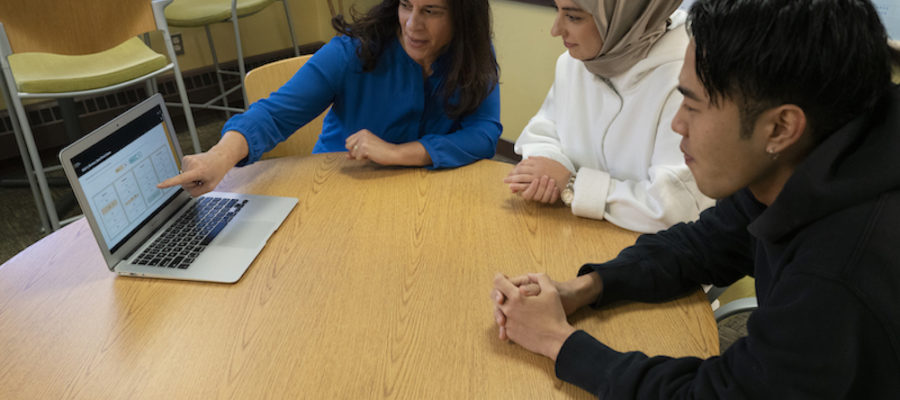In November of 2022, National Geographic Learning hosted two panels titled ‘The Evolving World of English Learning: A School’s-Eye View‘ featuring the perspective of several educators. Following the discussions, the panelists reflected on the question ‘What are the most important lessons you’ve learned in preparing multilingual students to study some or all of the curriculum in English?‘. In this blog post, you will find five perspectives on this question.
Andrew McNally
English Teacher at the American International School of Kuwait
Assistant Examiner for International Baccalaureate Language and Literature
Most Important Lessons for Preparing Multilingual Students to Study:
Build a Can-Do Language Community. The more confidence students have, the more they’ll communicate. The more they communicate, the better they’ll get. Expect big things from students but work from their strengths, emphasize growth, and inspire confidence that they can meet their goals.
All of the Above. Don’t stick with a single strategy. Use activities that blend, for example, learning listening and reading skills with writing and speaking skills. Balance direct instruction with inquiry learning. If students are learning question construction, grammar exercises might only hone students’ writing and syntax skills. But an interview activity with a partner gives students practice in listening, reading, writing, speaking, and vocabulary skills – and it’s more engaging and demanding.
One Size Doesn’t Fit All. Know your students’ needs and strengths and always ask how the teaching strategy serves those needs. If you notice that students’ biggest growth area is in relative clauses and sentence complexity, does it make sense to focus on a skill they have already mastered, like subject-verb agreement? If students have excellent written accuracy but struggle with speaking fluently, does it make sense to give students a lot of corrective feedback? If students need support in understanding the conventions of a letter, does reading Romeo and Juliet make much sense?
Affirm Students’ Home Language, Culture, and Goals. Incorporate a translation mini-unit. Create a multilingual classroom environment. Use translanguaging strategies like Preview-View-Review. Students learn best when they can make connections across languages and to their goals.
Keep It Visual. Images increase the comprehensibility of instruction and make great pieces to build conversation and writing around.
Every Student Participates in Every Class. The kind of participation might vary, but I always make clear that all students must talk, write, or contribute to the class community in every class period in the target language. Warm-ups and icebreakers that build engagement while practicing skills are a great way to build an ethos of participation.
Mahmoud Salman
Head of the English department at Global Bilingual Academy in Kuwait
It is widely known that multilingualism practices aim at developing the general acquisition of cross-cultural learners. As an educator for 15 years in the field of EFL and ESL, I learned a lot about how to effectively get as close as possible to the reality the new generation of students is living in the ever-changing world around them.
First and foremost, I learned that it is vital to be able to connect and relate the learning of a new language with who your audience is. Connect it to their values and culture so they will not refuse it; connect it to their reality so that they will accept its importance and appreciate its usage and acquisition.
Moreover, I believe that in the environment of ESL and EFL maximum exposure is vital to learning. Students must have the chance to be engaged and completely immersed in the language not only in the field of Arts, but also in others subjects such as Math, Science, and Information Technology. This would help them gain maximum benefit from their time in school.
At the same time, I realized that Language and Arts are two segments that should be coherent and comprehensive to each other in terms of integration. They complement each other rather than being separate items.
In conclusion, what matters the most is the target in mind rather than the way to achieve it. What may work with a group of learners in one part of the world may not work with another, due to the unique culture and environment each group may have. Designing a curriculum needs a deliberate effort to maximize engagement, and integration of skills, as well as appreciation of their surroundings.
Marisa Monroe
Instructional Coach and Curriculum Coordinator at Global Educational Excellence, United States and Saudi Arabia
I once read a quote from one of my many heroes, Carol Dweck, the mother of Growth Mindset, that moved me so much, I printed it out and placed it on the door of my classroom so it would be the first words anyone, including myself, would read before entering our learning space. “No matter what your current ability is, effort is what ignites that ability and turns it into accomplishment.” These words resonate with me now as much as ever, if not more so. I especially reflect on them as I consider the most important lessons I have learned in preparing multilingual students to study the curriculum in English.
The degrees of language ability of my incoming students have varied tremendously, from those who are already highly proficient in their native tongue as well as perhaps a second language, to those who have experienced great adversity resulting in limited to no schooling and limited proficiency in their home language. But regardless of where my students are coming from, we work together to focus on where they are going through building strong relationships, celebrating efforts and every success and, of course, practicing Growth Mindset.
I am committed to meeting students where they are, recognizing their current language reality, and then making data-informed decisions to drive research-based instruction to ignite that ability! I have learned to begin each day with the staunch belief that every student CAN, WILL, and DESERVES to gain English language proficiency. With this, I have witnessed both measurable and immeasurable growth in students in both their English language literacy achievement and overall confidence.
Sergio Morales
IB DP and MYP Coordinator at a private school in Mexico called Colegio Ciudad de México
Some of the most important lessons I’ve learned are as follows: Firstly, the way I was taught is not at all guaranteed to work for these students. Their reality has changed, and my reality has changed. I must reflect, look back, and acknowledge that I was not at the peak of my English level when I was 17 years old and had 5-8 hours of English lessons a week. I became fully aware of the need for the English language when I really needed it in real-life situations (in both the personal and the professional environments).
Secondly, remnants of the idea that classical literature is the only pathway to significant learning must be avoided. Literature is a pathway; yes, it is. However, the world of literature is vast and ever-changing. A literature-teaching focus only works if the literature is significant to both teacher and student. If you feel that a language arts focus is needed, then do your own research and reading for pleasure. Demonstrate, by example, that you can be a reader and not just a teacher. I’ve always felt that preaching about literature is easy when your teacher’s book edition makes you look like a pro because it has all the answers and you have taught the same lesson repeatedly for several years.
Finally, I would like to say that multilingual students are a newer breed of English learners and speakers (indeed, language learners in general). The world around them is not as strict as the privileged white class of America or Britain were over the second half of the twentieth century. The expectations are not about propriety of language, but rather of effectiveness and precision in terms of the task at hand within whichever curriculum or class.
Johan Mells
Secondary English Coordinator at Shanghai HD, China
The most important lessons I have learnt during my time preparing multilingual students are possibly easier, yet harder, to apply depending on the teacher’s personality. I think the main takeaway from it all has been that when you are interacting in a society where the students are not only unsure of themselves, as most adolescents usually are at this age, but throw in the additional dynamics of being socially awkward and you get an audience that is standoffish and non-receptive in default mode. So, my gameplan from day one is to create an atmosphere in the classroom that is so completely comfortable and safe for all the students involved.
Making them understand that the classroom is a space to make mistakes in and feel okay about it is paramount. Without that buy-in it becomes difficult to break down their barriers. It is so important to find their currency, the thing that makes each individual tick and incorporate that into their learning experience, making sure to then choose topics that can easily cross over into another topic. In the end, the goal is to get them to become global learners by using their own interests to get them interested in more things and have them expand their horizons through natural curiosity nurtured through the lessons and the other interactions with students in class.







